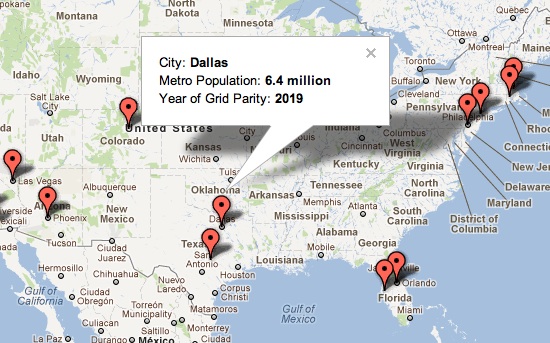
What happens if and when current subsidies for solar panels are phased out? Doesn't matter — the cost of solar photovoltaics continues to fall even as the cost of grid electricity continues to rise, which means eventually the two trends will meet and it will make more sense to put panels on your roof than to continue sending a check to your utility company.
In San Diego, this will happen sometime around 2013, according to a new animated map from John Farrell at Energy Self-Reliant States. The high cost of grid electricity and the fact that San Diego gets 367 days of sunshine a year will make it the first city where solar is cheaper. By 2020, most of the major metropolitan areas in California, the southwest, and a swath from Philly to Providence will have reached "grid parity." Even Texas, a state where electricity is fairly cheap thanks to an abundance of coal and wind farms, will have cities where it makes more sense to go solar.
By 2027, 150 million people — half the present population of the U.S. — could profitably go solar and never look back. Even the CEO of the utility company NRG says many of his customers will be able to switch to solar power within the next three to five years. Sounds like a revolution.
This isn't, by the way, an argument for eliminating federal and state subsidies for solar power. Every nascent energy industry has received such funds (nuclear being a prime example), and even entrenched fossil-fuel energy sources continue to get enormous subsidies, making the energy market anything but a level playing field. Continued solar subsidies are essential to maintain the momentum of an industry that has the potential to completely transform how we produce and consume electricity in this country. (Which is precisely why the big-money-entrenched interests in the fossil fuels and other energy industries hate it.)


